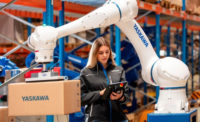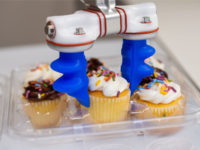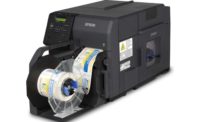Boosting overall operational efficiency often means automating more downstream operations, such as case packing, warehousing and related systems once dependent on manual labor. To a large degree, palletizing, transferring and conveying products are now robotic and automated, and development in these areas continues.
Automation helps bakers and snack producers quickly respond to fast-changing market demands and ever-shifting consumer tastes. “Flexibility once meant leaving the end of the line as a manual operation,” says Rob Thompson, southeast regional sales manager, BluePrint Automation, South Chesterfield, VA. “Now-—and going forward—new automation technologies allow for high speeds and quick changeover, all while reducing costs and meeting demanding ROI.”
Measures of quality
Automating these processes can lead to an uptick in quality. “The need to automate continues to flow downstream, especially in instances where the product or packaging can be inspected using methods other than the human eye,” says Thompson. “Vision-guided systems give food processors the ability to inspect and reject products prior to performing the primary task. Automated palletizing, stretch wrapping and warehousing are now commonplace.”
Due to significant technical advances in these and other manufacturing areas, automation can now be deployed more frequently where it has been problematic in the past. For instance, innovative end-of-arm tooling (EOAT) can pick and place light, fragile and irregularly shaped products with a high degree of consistency and speed and less product damage.
“Vision has migrated to more of a 3-D perspective, from a 2-D basis, thus adding depth, better location, contrast and color for overall functionality,” says Jack Uhl, regional sales manager, Yaskawa America Inc., Motoman Robotics Division, Miamisburg, OH. “Vision also has improved its lighting tolerances and ease of integration.”
Rick Hoskins, vice president, Colborne Foodbotics, Lake Forest, IL, says: “Robotic system sales have been rising steadily over the past few years, and new applications are being developed. To compete, most integrators are adding creative features that provide additional utility.” He notes that recent developments include features that minimize changeover, maximize product transfer efficiency, reduce manpower and improve safety.
Scott Gilmore, CEO, Smart Motion Robotics Inc., Sycamore, IL, says robotics is a particularly good fit for bakery and snack food applications. “Robotic systems tend to have a smaller footprint than fixed automation systems, hence saving floor space,” he adds.
Automation not only helps bakers and snack producers run their production lines more efficiently, it can also help them reduce labor costs. Kevin Pearson, vice president, Arr-Tech Inc., Yakima, WA, notes that systems include vision inspection prior to counting and stacking, as well as after the product is stacked, which eliminates the need for manual labor at the downstream end of operations.
Automation innovations
A number of companies offer new and enhanced equipment that enables bakers and snack producers to automate their production lines, improve efficiency, and reduce production and labor costs.
Developments in vision-guided robotic capabilities present a clear benefit to snack producers. “We now have a newly designed EOAT that is very gentle when picking delicate product,” Thompson notes.
New unified control platforms permit easy programming of robots via existing programmable logic controllers (PLCs). This eliminates the duplicity of robot original equipment manufacturer (OEM) programming, language and floor-mounted controllers. “This unified control also permits motion controllers to program robots via a unified platform, utilizing a global IEC 611 format,” Uhl explains.
Vertical horizontal case packers are designed to be placed downstream of bag-making machines, like vertical form/fill/seal units. Such units can load bags lying down in cases, such as regular slotted cases (RSC), as well as load upright packages. “With the trend toward stand-up bags in display-ready cases, we believe it’s the right time to introduce this machine,” says Tom Sosnoski, product manager, Bosch Packaging Technology Inc., New Richmond, WI.
Hoskins notes the development of a four-bay system serviced by a single robot. Three bays accept incoming stacks of loaded baskets; the final bay accepts empty baskets that are stacked and released when full. The application is designed to process croutons and stuffing mix.
“The control system self-monitors the recipes and operates the robot to locate the various bread loaves based on flavors required to produce the final product,” Hoskins explains. “The robot picks up the basket, loaded with 10 loaves of dried bread, and carries the basket to the stacker, where it is placed on the stack. It then carries the 10 bread loaves to one of three output conveyors leading to the cubing process.”
Integrating equipment functions is an important development in automation, according to Mike Wagner, global OEM segment business manager for packaging, Rockwell Automation, Milwaukee. Bakers and snack producers, OEMs and system integrators can use systems to reduce startup and commissioning time, he says. The virtualized system integrates with other equipment, such as packaging and palletizing machines.
“With an updated batch and sequence manager, machine builders and system integrators can reduce engineering time by configuring sequences directly in the controller,” says Wagner. “The batch and sequence manager incorporates batch management and optimizes continuous sequencing. It’s well-suited for both skid control and stand-alone process units, such as mixers, blenders and reactors.”
Manufacturers are also asking for system features that collect and analyze data to optimize their automation processes, Wagner adds. He cites, as an example, software that can extract, analyze and contextualize 1,000 data points from batching and refrigeration processes. Alerts and reports help the company validate specifications and raw material usage, increase product consistency and determine the root cause of process upsets. “Real-time insights allow the company to take corrective action, minimizing potential for production loss or safety risk,” he says. This can lead to notable cuts in energy usage—and capital savings.
Pearson agrees that more food processors are asking for data feedback as a means to improve their downstream production processes. That’s the reasoning behind integrating vision/inspection systems into automated systems, which can collect data on production statistics, measures and waste analysis. “The data is automatically generated; reports can be emailed by shift, day, week or month to key personnel,” he explains. “The vision systems are capable of gathering real-time information on product that is being rejected.”
Equipment design challenges
Some of the challenges manufacturers face when designing automation for bakers and snack producers include lack of available floor space in production facilities to provide automation options and the wide range of products the equipment must be able to handle.
“Tooling for robotics must handle a broad spectrum of products, product profiles and packaging configurations without the need for a complete tool changeover,” says Uhl. “Designing the packaging line to permit quick changeover is another challenge.”
From the equipment manufacturer’s standpoint, providing ever more flexible machines, while maintaining a small equipment footprint, is challenging, according to Sosnoski. “We see many companies trying to differentiate their brands on the store shelf while reducing materials costs,” he says. “As a result, there are always new cases and package designs to vet against our existing machine portfolio.”
New automation equipment is being designed to accommodate new food-safety regulations, as well. “We see a growing interest in the incorporation of inspection into our product handling and packing equipment,” says Craig A. Souser, president/CEO, JLS Automation, York, PA. “In addition, we see increased interest in higher sanitary construction. Painted equipment is less accepted, especially in bakeries. We even see some bakeries using wash down of automation equipment in areas that typically did not in the past.”
And bakers and snack producers are requesting a host of other features on automated and robotic equipment to help make the end of their production lines more efficient: auto-run sequences to eliminate operator error, safety-lock systems to prevent accidents, automatic tooling changeovers to reduce downtime, pan-to-container in a single move, auto adjustment of a wide range of containers sizes to reduce changeover time and eliminate time-consuming hardware modifications, remote access of system operations for troubleshooting and repair, and software-based systems for future flexibility.
While this list of “wants” may seem daunting to some OEMs, leading automated and robotic equipment manufacturers realize that it’s simply a good starting point for taking bakers and snack producers to the next manufacturing level.











